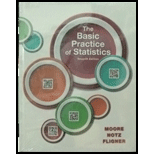
Concept explainers
a.
To write: All the eight possible arrangements for the boy and girl child.
To find: The probability for any one of the eight possible arrangements for the child.
a.
Answer to Problem 12.48E
The eight possible arrangements for the boy and girl child are given below,
The probability to get first two girls and a boy is
Explanation of Solution
Given info:
A couple has planned to have three child, eight possible arrangements for the girl and boy are possible. All these eight arrangements are equally likely to occurrence.
Justification:
The sample space is defined as the set of all possible outcomes from an experiment.
The total number of possible outcomes is,
A couple plans to have three children. One of the possible combinations to have three children is “Girl, Girl or Boy”. Similarly, the other possible combinations can be obtained.
All the eight possible arrangements for the boy and girl child are the sample space S which is given below:
Where, G represents the girl child and B represents the boy child.
Calculation:
Equally likely events:
An
Since, the eight possible arrangements are equally likely to occur. The probability for one of the eight possible arrangements is calculated as follows:
Thus, the probability for getting any one from the eight possible arrangements is
b.
To find: The probability that
b.
Answer to Problem 12.48E
The probability that the couple have two girl children is
Explanation of Solution
Given info:
Assume that X denotes the number of girls that the couple has.
Calculation:
Let the number of girls X that the couple has equals to 2 girls.
The outcomes for 2 girls are
The probability that the couple have two girl children is calculated as follows:
Thus, the probability that the couple have two girl children is
c.
To find: The values of X and the probability distribution for X.
c.
Answer to Problem 12.48E
The values taken by X are 0, 1, 2, and 3.
The probability distribution is given below:
| X | 0 | 1 | 2 | 3 |
| Probability |
Explanation of Solution
Calculation:
Random variable:
The random variable is a variable which has numerical values or outcomes obtained from a random experiment.
Finite Probability Model:
A probability model with a finite sample space is called the finite probability model.
Assigning probabilities to the finite probability model:
- List all the probabilities for all individual outcomes.
- These probabilities should lie between 0 and 1 and the total sum of all probabilities exactly equal to 1.
- The probability for occurrence of any event is the sum of individual probabilities of that event.
Values of X:
The random variable X takes values 0, 1, 2, 3 because the couple has planned to have 3 children and X denotes the number of girl child. So, the possible number of girl child the couple can have is 0, 1, 2, and 3.
Probability distribution for X:
Let the number of girls X that the couple has equals to 0. The possible outcome is
The probability to have no girl child is calculated as follows:
Thus, the probability to have no girl child is
Let the number of girls X that the couple has equals 1. The possible outcomes are
The probability to have 1 girl child is calculated as follows:
Thus, the probability to have one girl child is
Let the number of girls X that the couple has equals 2. The outcomes for 2 girls are
The probability to have 2 girl children is calculated as follows:
Thus, the probability to have two girl child is
Let the number of girls X that the couple has equals 3. The possible outcome is
The probability to have 3 girl children is calculated as follows:
Thus, the probability to have three girl child is
The probability distribution is given below:
| X | 0 | 1 | 2 | 3 |
| Probability |
Want to see more full solutions like this?
Chapter 12 Solutions
Bundle: Basic Practice of Statistics 7e & LaunchPad (Twelve Month Access)
 MATLAB: An Introduction with ApplicationsStatisticsISBN:9781119256830Author:Amos GilatPublisher:John Wiley & Sons Inc
MATLAB: An Introduction with ApplicationsStatisticsISBN:9781119256830Author:Amos GilatPublisher:John Wiley & Sons Inc Probability and Statistics for Engineering and th...StatisticsISBN:9781305251809Author:Jay L. DevorePublisher:Cengage Learning
Probability and Statistics for Engineering and th...StatisticsISBN:9781305251809Author:Jay L. DevorePublisher:Cengage Learning Statistics for The Behavioral Sciences (MindTap C...StatisticsISBN:9781305504912Author:Frederick J Gravetter, Larry B. WallnauPublisher:Cengage Learning
Statistics for The Behavioral Sciences (MindTap C...StatisticsISBN:9781305504912Author:Frederick J Gravetter, Larry B. WallnauPublisher:Cengage Learning Elementary Statistics: Picturing the World (7th E...StatisticsISBN:9780134683416Author:Ron Larson, Betsy FarberPublisher:PEARSON
Elementary Statistics: Picturing the World (7th E...StatisticsISBN:9780134683416Author:Ron Larson, Betsy FarberPublisher:PEARSON The Basic Practice of StatisticsStatisticsISBN:9781319042578Author:David S. Moore, William I. Notz, Michael A. FlignerPublisher:W. H. Freeman
The Basic Practice of StatisticsStatisticsISBN:9781319042578Author:David S. Moore, William I. Notz, Michael A. FlignerPublisher:W. H. Freeman Introduction to the Practice of StatisticsStatisticsISBN:9781319013387Author:David S. Moore, George P. McCabe, Bruce A. CraigPublisher:W. H. Freeman
Introduction to the Practice of StatisticsStatisticsISBN:9781319013387Author:David S. Moore, George P. McCabe, Bruce A. CraigPublisher:W. H. Freeman





